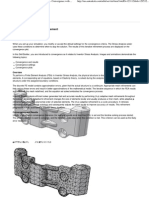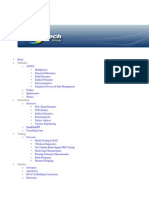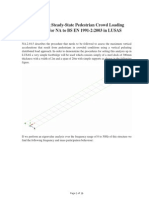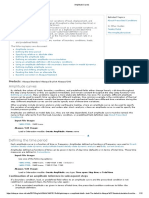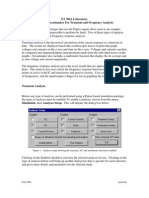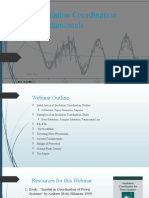Base Acceleration in Harmonic Analysis Using ANSYS Mechanical (Workbench) v14-5
Base Acceleration in Harmonic Analysis Using ANSYS Mechanical (Workbench) v14-5
Uploaded by
khers_zalCopyright:
Available Formats
Base Acceleration in Harmonic Analysis Using ANSYS Mechanical (Workbench) v14-5
Base Acceleration in Harmonic Analysis Using ANSYS Mechanical (Workbench) v14-5
Uploaded by
khers_zalCopyright
Available Formats
Share this document
Did you find this document useful?
Is this content inappropriate?
Copyright:
Available Formats
Base Acceleration in Harmonic Analysis Using ANSYS Mechanical (Workbench) v14-5
Base Acceleration in Harmonic Analysis Using ANSYS Mechanical (Workbench) v14-5
Uploaded by
khers_zalCopyright:
Available Formats
Base Acceleration in Harmonic Analysis using ANSYS Mechanical (...
1 of 5
http://www.simutechgroup.com/FEA/fea-tips-tricks-ansys-base-accelerat...
(http://www.simutechgroup.com)
HOME
BLOG
Home (/)
(/)
SOFTWARE
CONSULTING
TESTING
(HTTP://BLOG.SIMUTECHGROUP.COM/)
Support
INDUSTRY
CONTACT US
SUPPORT
(/OFFICES/)
TRAINING
ABOUT US
ANSYS Tips & Tricks
BASE ACCELERATION IN HARMONIC ANALYSIS USING ANSYS
MECHANICAL (WORKBENCH) V14.5 (/FEA/FEA-TIPS-TRICKS-ANSYSBASE-ACCELERATION-HARMONIC-ANALYSIS.HTML)
Figure 1: Modal Analysis and Full Harmonic AnalysisNo Link from Modal Solution
ANSYS Mechanical APDL and Mechanical (Workbench) can perform harmonic analysis on a structure, determining the steady-state
sinusoidal response to sinusoidal varying loads all acting at a specified frequency. Some load types can be applied with a phase offset.
Figure 1 above shows the Workbench Project Schematic for a Harmonic analysis, and includes a Modal analysis to characterize the
structure. This Harmonic analysis is not using modal superposition, as can be seen in the fact that Solution results from the Modal analysis
are not linked.
Many structures are tested per customer specification with base accelerations swept across a range of frequencies. Such a test can be
implied by fixing a base in ANSYS, and applying an acceleration load to the whole model with an ACEL command. The resulting movement
at a point on the FEA model is relative to a fixed non-moving base, and is not what would be picked up at the point with an accelerometer.
To replicate acceleration movements at a base would require an acceleration input at selected geometry, which ANSYS does not directly
support in Harmonic analysis.
This article illustrates conversion of an acceleration harmonic input into a displacement input, and its use in an ANSYS Workbench model.
Such an input should result in model movements that replicate what should be picked up by a physical accelerometer placed on the
product, since they include base movement.
Loads on Harmonic Models
A 3D solid beam model was created with one end fixed:
3/19/2015 2:21 PM
Base Acceleration in Harmonic Analysis using ANSYS Mechanical (...
2 of 5
http://www.simutechgroup.com/FEA/fea-tips-tricks-ansys-base-accelerat...
Figure 2: Fixed--Free Beam, 3D Solid Model
A modal analysis quickly shows the first several natural frequencies of vibration of this model:
Figure 3: Natural Frequencies of the Beam
The same geometry and mesh are used in a Harmonic analysis in Workbench. The harmonic load is applied at the fixed end of the beam
with X and Z movements fixed, but a UY harmonic displacement applied. An APDL test will show that although the ANSYS command D for
a non-zero displacement can support velocity or acceleration input in some structural analyses, these inputs are not supported in a
Harmonic analysis:
*** ERROR ***
CP =
2.824 TIME= 08:58:19
Velocity or acceleration boundary conditions in a harmonic analysis or
a prestressed harmonic analysis is not supported.
A non-zero displacement load can be applied in a Harmonic analysis. When a specification calls for a velocity or acceleration load to be
applied to selected geometry in a harmonic vibration test, ANSYS commands can convert the specified velocity or acceleration load into a
displacement load and apply it to the geometry with a Table Array as a function of frequency.
Harmonic excitation velocity is harmonic displacement multiplied by angular frequency , which is 2 multiplied by frequency f, and phase
shifted by 90 degrees, which in complex notation means multiplied by i. Acceleration is velocity multiplied by and phase shifted another
90 degrees, so multiplied by another i.
d = displacement
v = velocity
a = acceleration
f = frequency
= 2f
v = id
a = -2d
Conversion from a specified harmonic acceleration a to a non-zero displacement amplitude d means forming:
d = -a/2 = -a/(2f)2
When a specification calls for an acceleration to be applied to a base or other selected geometry on a structure, it can be converted to an
applied non-zero displacement as a function of frequency in this manner.
In the present example, a constant acceleration value is to be applied across a range of frequencies. A Table Array can be used in ANSYS
to achieve this. To apply a non-zero harmonic displacement requires Full harmonic analysis. The following APDL Commands Object at the
Environment level applies such a load to nodes in the Named Selection (component) called End_Face. In this example, a constant
acceleration of 10 mm/sec2 is converted to displacement as a function of frequency.
A frequency range of 5 to 1000 Hz is used for illustration:
! Acceleration Input in Y on nodes of component "End_Face"
3/19/2015 2:21 PM
Base Acceleration in Harmonic Analysis using ANSYS Mechanical (...
3 of 5
http://www.simutechgroup.com/FEA/fea-tips-tricks-ansys-base-accelerat...
cmsel,s,End_Face ! nodes on Named Selection "End_Face"
myaccel=10
points=200
! more points for better accuracy
start_freq=5
end_freq=1000
twopi=2*acos(-1) ! must be radians
stepsize=(end_freq-start_freq)/(points-1)
*dim,my_uy,table,points,,,TIMEn
! TIME implies frequency
*do,ii,1,points
freq=start_freq+stepsize*(ii-1) ! frequency
my_uy(ii,0)=freq
omegasq=(twopi*freq)**2
my_uy(ii,1)=-myaccel/omegasq
! amplitude
*enddo
!
d,all,uy,%my_uy%
! apply UY as function of frequency
allsel
The frequency range in the APDL code above must span or exceed the range of frequencies to be employed in a sweep of harmonic
analysis frequencies. The Table Array method used here will apply displacement amplitudes as a function of frequency during the SOLVE of
the model. It is assumed here that there is no phase shift in the applied acceleration. Note the implied 180 degree phase shift in the minus
sign on the displacement value.
The Outline for the example shows the Named Selection used in the above APDL code, and the placement of the APDL code in the
Harmonic Response environment. Since the above APDL places a non-zero displacement in the UY direction on the face that is fixed in the
modal analysis, other objects constrain the face movement in X and Z:
Figure 4: APDL Commands in a Harmonic Response Analysis in Workbench
In the event that a specification called for harmonic acceleration input that is not constant with respect to frequency, the APDL coding could
be adjusted to use the acceleration value in the line:
my_uy(ii,1)=-myaccel/omegasq
! displacement
as a function of frequency. As an example, if the acceleration was to satisfy this table:
Frequency in Hz Acceleration Amplitude, mm/sec^2
5
50
100
50
900
50
1000
The APDL code might represent the acceleration value with at Table Array:
*dim,myaccel,table,5,1
myaccel(1,0)=5,50,100,900,1000 ! Frequencies in cycles per second
myaccel(1,1)=5,5,50,50,5
! Acceleration amplitudes
The displacement line in the above coding would be modified to look up the input acceleration:
my_uy(ii,1)=-myaccel(freq)/omegasq
3/19/2015 2:21 PM
Base Acceleration in Harmonic Analysis using ANSYS Mechanical (...
4 of 5
http://www.simutechgroup.com/FEA/fea-tips-tricks-ansys-base-accelerat...
Outputs from the Example Model
When the input acceleration is a function of frequency, as just above, then the Frequency Response where the load is applied can be traced
in the Solution output. For the above variable acceleration example, a plot shows:
Figure 5: Frequency Response for Accelation in Y at the Base
As desired, the above Figure 5 response plot of acceleration in Y matches the data entered with the lines:
myaccel(1,0)=5,50,100,900,1000
myaccel(1,1)=5,5,50,50,5
Although ANSYS and Workbench cannot take an applied velocity or acceleration as a harmonic displacement input at nodes, Workbench
can plot the acceleration frequency response, which can be used to verify that the desired acceleration loading was applied via the
displacement table array method.
In the above example, the frequency sweep passes through a resonance with motion in the UY direction, as can be seen in these frequency
response plots of tip UY displacement and UY acceleration:
Figure 6: Displacement and Acceleration Response of the Tip of the Fixed-Free Beam Example
The damping in this example is only 2%, so to resolve the sharp peak in the response would require a finer density of frequency sampling
points than was used here.
Conclusions
Specifications sometimes call for products to be subject to harmonic acceleration loading applied to the base of the product. If absolute
accelerations are to be measured at points on the product, a harmonic finite element analysis would be best run with non-zero acceleration
inputs at a base. ANSYS supports only non-zero displacement loading at nodes in harmonic models. The desired non-zero harmonic
acceleration loading can be converted to displacement as a function of frequency, and the desired load applied in ANSYS via a Table Array
that is a function of frequency (referred to as TIME in the table array).
APDL coding can apply the desired loading on faces indicated via Named Selections in an ANSYS Workbench analysis.
Frequency response plots at the base where the loads are applied can be used to confirm that the desired displacement and acceleration
loads were input. Frequency response plots at other points in the model can show the absolute (relative to the global origin, not relative to
the base) displacement and acceleration results elsewhere in the model.
The usual displacement, stress and strain plots can be generated. Users should note that chosen frequencies and phase angles must be
manually entered in many of the results plot object details. In the use of APDL commands as illustrated above, the correct units must be
used in the accelerations and displacements, and these units must be employed in the SOLVE of the Workbench model.
3/19/2015 2:21 PM
Base Acceleration in Harmonic Analysis using ANSYS Mechanical (...
5 of 5
http://www.simutechgroup.com/FEA/fea-tips-tricks-ansys-base-accelerat...
Figure 7: Vertical Displacement at Frequency Point Closest to Resonance
In Figure 7 above, note that the Frequency and its associated Phase Angle have been manually entered in Details in order to plot vertical
displacement at the frequency that is closest to resonance. The UY vertical displacement at the base (the left end) can be seen to be
non-zero, because the desired acceleration condition at the base was applied by using the related non-zero displacement as the harmonic
input.
Copyright 2015 SimuTech Group. All Rights Reserved.
3/19/2015 2:21 PM
You might also like
- Book Index The Art of Heavy TransportDocument6 pagesBook Index The Art of Heavy TransportHermon Pakpahan50% (2)
- 111111Document23 pages111111Franch Maverick Arellano LorillaNo ratings yet
- ANSYS Tutorial Seismic AnalysisDocument11 pagesANSYS Tutorial Seismic AnalysisArut MV100% (1)
- Autodesk Inventor - Convergence With Mesh RefinementDocument4 pagesAutodesk Inventor - Convergence With Mesh RefinementNdianabasi UdonkangNo ratings yet
- Appendix A PDFDocument20 pagesAppendix A PDFqaeszNo ratings yet
- RSPMatch2005 Manual V1Document9 pagesRSPMatch2005 Manual V1unreachable_UKNo ratings yet
- Fencing ManualDocument42 pagesFencing Manualkhers_zalNo ratings yet
- Samwha Eocr Digital Catalog - enDocument54 pagesSamwha Eocr Digital Catalog - enmuhammad wafi100% (1)
- Measuring Force On A Point Mass in ANSYS® Mechanical (Workbench)Document8 pagesMeasuring Force On A Point Mass in ANSYS® Mechanical (Workbench)deepak_dce_meNo ratings yet
- ANSYS Tutorial EarthquakeDocument11 pagesANSYS Tutorial EarthquakegutekgieNo ratings yet
- Apdl in WorkbechDocument14 pagesApdl in Workbechkiran_wakchaureNo ratings yet
- ANSYS Tutorial - Earthquake Analyses in Workbench - EDRDocument11 pagesANSYS Tutorial - Earthquake Analyses in Workbench - EDRnetkasia0% (1)
- University of Alberta ANSYS Tutorials - NonLinear AnalysisDocument6 pagesUniversity of Alberta ANSYS Tutorials - NonLinear AnalysisRithesh Baliga BNo ratings yet
- Performing Steady-State Pedestrian Crowd Loading To BS en 1991-2 2003Document16 pagesPerforming Steady-State Pedestrian Crowd Loading To BS en 1991-2 2003Milind GuptaNo ratings yet
- ANSYS Tutorial - Earthquake Analyses in Workbench - EDR&MedesoDocument9 pagesANSYS Tutorial - Earthquake Analyses in Workbench - EDR&MedesoBobKatNo ratings yet
- 17.4. Harmonic Response AnalysesDocument19 pages17.4. Harmonic Response AnalysesĐại Sứ Thiện ChíNo ratings yet
- Earthquak Analysis in AnsysDocument14 pagesEarthquak Analysis in AnsysIgor GjorgjievNo ratings yet
- Harmonic Analysis of A Cantilever Beam: Command Line Codes GUI CommandsDocument8 pagesHarmonic Analysis of A Cantilever Beam: Command Line Codes GUI CommandsJA KNo ratings yet
- Earthquake Analyses in Ansys WorkbenchDocument14 pagesEarthquake Analyses in Ansys WorkbenchEmmanuel Ikhaiduwor100% (1)
- Performing Steady-State Pedestrian Crowd Loading To BS EN 1991-2 2003Document14 pagesPerforming Steady-State Pedestrian Crowd Loading To BS EN 1991-2 2003Jesús Rodríguez RodríguezNo ratings yet
- EVALUE PspiceDocument7 pagesEVALUE Pspicejjtop1001No ratings yet
- Harmonic AnalysisDocument10 pagesHarmonic AnalysisBalu ZerofourNo ratings yet
- Applying Orthogonal Combination Procedure As Per ASCE-7-05 For SDC C in Etabs Program. - Computers and Structures - ETABS - Eng-TipsDocument2 pagesApplying Orthogonal Combination Procedure As Per ASCE-7-05 For SDC C in Etabs Program. - Computers and Structures - ETABS - Eng-TipsCristian Camilo Londoño Piedrahíta100% (2)
- Auto Noise Vibration Harshness Analysis Full Vehicle 07Document6 pagesAuto Noise Vibration Harshness Analysis Full Vehicle 07palgunahgNo ratings yet
- Eric Sauther Sine Sweep TutorialDocument18 pagesEric Sauther Sine Sweep TutorialbackvlackoNo ratings yet
- TarDocument8 pagesTarLe Huyen Vu MyNo ratings yet
- NonLinear Analysis PDFDocument13 pagesNonLinear Analysis PDFವಿನಯ್ ಎಮ್. ಆರ್No ratings yet
- Hamza Ali Lab Report 04Document26 pagesHamza Ali Lab Report 04Hafiz MuhammadNo ratings yet
- Gaussian OptimizationDocument8 pagesGaussian OptimizationMark Cliffton BadlonNo ratings yet
- Lab 02 - Seismic Data QCDocument6 pagesLab 02 - Seismic Data QCapi-323770220No ratings yet
- Microstran EquarkeloadDocument6 pagesMicrostran Equarkeloadshantanu chowdhuryNo ratings yet
- Z Eigen Value Calculation in AnsysDocument17 pagesZ Eigen Value Calculation in AnsysPramod Rakt PatelNo ratings yet
- Week 5-1Document4 pagesWeek 5-1ibrahimNo ratings yet
- 1SP02 EMC32 DataReduction V1Document46 pages1SP02 EMC32 DataReduction V1AndreeaNo ratings yet
- AACTx R160 L-06 Advanced ApplicationsDocument19 pagesAACTx R160 L-06 Advanced ApplicationsPercy Romero MurilloNo ratings yet
- Scaling of Base Shear in ETABS - Structural CalcDocument19 pagesScaling of Base Shear in ETABS - Structural CalcAboalmaail AlaminNo ratings yet
- Transient Dynamic AnalysisDocument14 pagesTransient Dynamic Analysissunil481100% (1)
- Model HVSRDocument3 pagesModel HVSRbeten01No ratings yet
- Amplitude Curves in ABAQUS CAEDocument12 pagesAmplitude Curves in ABAQUS CAELogicAndFacts ChannelNo ratings yet
- Footfall Verification ExampleDocument6 pagesFootfall Verification ExampleAdrian Diez0% (1)
- Session 50 Theory of Explicit Dynamic AnalysisDocument12 pagesSession 50 Theory of Explicit Dynamic AnalysisPraveen MalikNo ratings yet
- Noise, Vibration, and Harshness (NVH) Analysis of A Full Vehicle ModelDocument5 pagesNoise, Vibration, and Harshness (NVH) Analysis of A Full Vehicle ModelFábio Bresciani ValverdeNo ratings yet
- Harmonic Analysis Tutorial CAEPIPEDocument6 pagesHarmonic Analysis Tutorial CAEPIPEpmr80_2004No ratings yet
- Tutorial For Harmonic Analysis Using CAEPIPE: GeneralDocument6 pagesTutorial For Harmonic Analysis Using CAEPIPE: GeneralsaravananNo ratings yet
- Ansys Linear Buckling PDFDocument5 pagesAnsys Linear Buckling PDFJun Qian100% (1)
- Sas Arma ForecastDocument11 pagesSas Arma ForecastSahil MakkerNo ratings yet
- Earthquake ChecksDocument34 pagesEarthquake ChecksMarian DragosNo ratings yet
- Material Nonlinearities and Geometric Nonlinearities (Change in Response Due To Large Deformations)Document7 pagesMaterial Nonlinearities and Geometric Nonlinearities (Change in Response Due To Large Deformations)api-3833671No ratings yet
- Er Ieee BPT TESISDocument6 pagesEr Ieee BPT TESISVladimirCoelloNo ratings yet
- Fracture Problems With ANSYS PDFDocument18 pagesFracture Problems With ANSYS PDFcasanovavnNo ratings yet
- APDL CommandsDocument49 pagesAPDL CommandsAmine BouNo ratings yet
- ET 304A Laboratory Tutorial-Circuitmaker For Transient and Frequency AnalysisDocument7 pagesET 304A Laboratory Tutorial-Circuitmaker For Transient and Frequency AnalysisZhong XiangNo ratings yet
- Harmonic Analysis of A Cantilever BeamDocument12 pagesHarmonic Analysis of A Cantilever Beamakroma123No ratings yet
- AAPA 2019asadiDocument9 pagesAAPA 2019asadizhizhang5591No ratings yet
- Rotor Dynamic Analysis of Electrical MachinesDocument6 pagesRotor Dynamic Analysis of Electrical Machinesbitconcepts9781No ratings yet
- Configuring A Transient Analysis in Multisim: TutorialDocument4 pagesConfiguring A Transient Analysis in Multisim: TutorialariasnomercyNo ratings yet
- Backpropagation: Fundamentals and Applications for Preparing Data for Training in Deep LearningFrom EverandBackpropagation: Fundamentals and Applications for Preparing Data for Training in Deep LearningNo ratings yet
- Investigation of the Usefulness of the PowerWorld Simulator Program: Developed by "Glover, Overbye & Sarma" in the Solution of Power System ProblemsFrom EverandInvestigation of the Usefulness of the PowerWorld Simulator Program: Developed by "Glover, Overbye & Sarma" in the Solution of Power System ProblemsNo ratings yet
- Control of DC Motor Using Different Control StrategiesFrom EverandControl of DC Motor Using Different Control StrategiesNo ratings yet
- Harnessing Bistable Structural Dynamics: For Vibration Control, Energy Harvesting and SensingFrom EverandHarnessing Bistable Structural Dynamics: For Vibration Control, Energy Harvesting and SensingNo ratings yet
- C02e AshxDocument186 pagesC02e AshxRanaJafaryNo ratings yet
- Conformal Coating 101Document9 pagesConformal Coating 101khers_zal100% (2)
- An Overview of Solder Bump Shape Prediction Algorithms With ValidationsDocument5 pagesAn Overview of Solder Bump Shape Prediction Algorithms With Validationskhers_zalNo ratings yet
- Element Quality Plots in ANSYS WB 16Document6 pagesElement Quality Plots in ANSYS WB 16khers_zalNo ratings yet
- MasterDocument28 pagesMasterkhers_zalNo ratings yet
- Parent Guide 1Document21 pagesParent Guide 1khers_zalNo ratings yet
- Special Animals ListDocument66 pagesSpecial Animals Listsile15No ratings yet
- Fencing Is A SportDocument34 pagesFencing Is A Sportkhers_zalNo ratings yet
- Animal Control Officers and Wild Animals: Incidental CaptureDocument2 pagesAnimal Control Officers and Wild Animals: Incidental Capturekhers_zalNo ratings yet
- ApplPhysLett 86 042904 PDFDocument4 pagesApplPhysLett 86 042904 PDFkhers_zalNo ratings yet
- Assignment 6Document1 pageAssignment 6khers_zalNo ratings yet
- Insulation Coordination Fundamentals: Nema 8LADocument62 pagesInsulation Coordination Fundamentals: Nema 8LADan Pelayo100% (1)
- EGN 3311 StaticsDocument4 pagesEGN 3311 StaticstucchelNo ratings yet
- Trafos Fuente SwitchingDocument17 pagesTrafos Fuente SwitchingTecno DeliveryNo ratings yet
- Internal Inspection Report HopperDocument10 pagesInternal Inspection Report HopperCepi Sindang KamulanNo ratings yet
- Water Distribution ModellingDocument693 pagesWater Distribution Modellingmjson72100% (7)
- Chapter 9 Energy ConDocument2 pagesChapter 9 Energy ConLuelsonCordovaDeclaradorNo ratings yet
- Power Factor Part 2Document5 pagesPower Factor Part 2Anonymous Cxriyx9HIXNo ratings yet
- Induction Motor: Navigation SearchDocument8 pagesInduction Motor: Navigation SearchSoni Mishra TiwariNo ratings yet
- GEAS Review GuideDocument15 pagesGEAS Review GuideSanny Domingo AfableNo ratings yet
- SVC in Power Substation and Electric ARc FurnacesDocument4 pagesSVC in Power Substation and Electric ARc FurnacesWilver SánchezNo ratings yet
- Menvier MF400Document12 pagesMenvier MF400JocafenoNo ratings yet
- Experiment 1 The Simple Pendulum & Hook's Law Nima Rahmani Mehdiabadi March, 13,2017Document10 pagesExperiment 1 The Simple Pendulum & Hook's Law Nima Rahmani Mehdiabadi March, 13,2017Nima RahmaniNo ratings yet
- Gear Noise Evaluation Through Multibody TE-based S PDFDocument15 pagesGear Noise Evaluation Through Multibody TE-based S PDFFiras BejarNo ratings yet
- Vector Control of Cage Induction Motors A Physical Insight, 1996 PDFDocument10 pagesVector Control of Cage Induction Motors A Physical Insight, 1996 PDFAli H. NumanNo ratings yet
- Physics Past PapersDocument30 pagesPhysics Past PapersNyraStardollNo ratings yet
- T SC 2549669 Science Knowledge Organiser Forces and Magnets Year 3 Ver 6Document2 pagesT SC 2549669 Science Knowledge Organiser Forces and Magnets Year 3 Ver 6meraa montaserNo ratings yet
- Dynamics of Ship Collisions: Doctoral DissertationDocument53 pagesDynamics of Ship Collisions: Doctoral DissertationEric KulbiejNo ratings yet
- Photo Electric Effect Ho 09 Jan EngDocument15 pagesPhoto Electric Effect Ho 09 Jan EngPsatis PatelNo ratings yet
- CT Sizing Calculations 3-5-2013Document21 pagesCT Sizing Calculations 3-5-2013Adeel ZafarNo ratings yet
- Aventics Coil Series CO1 Form BDocument3 pagesAventics Coil Series CO1 Form BCarlos Andrés CuelloNo ratings yet
- Conservation of EnergyDocument7 pagesConservation of EnergyJohn Nathaniel GutierrezNo ratings yet
- Fuzzy Logic Controller Based On Voltage Source Converter-Hvdc SystemDocument7 pagesFuzzy Logic Controller Based On Voltage Source Converter-Hvdc SystemBhuvneshRathoreNo ratings yet
- Nordic and Baltic Grid Disturbance Statistics 2018Document96 pagesNordic and Baltic Grid Disturbance Statistics 2018victor AjahNo ratings yet
- Apc Practice Problems 07-08 - Work Energy Power Springs - SolutionsDocument33 pagesApc Practice Problems 07-08 - Work Energy Power Springs - SolutionsBaynaa DaariimaaNo ratings yet
- Article - Predicting The Effect of Field ShaperDocument8 pagesArticle - Predicting The Effect of Field ShaperdurgaraokamireddyNo ratings yet
- Transformers: Chapter TwoDocument61 pagesTransformers: Chapter TwoomarNo ratings yet
- Physics Paper-1 & 2 (Xyz)Document10 pagesPhysics Paper-1 & 2 (Xyz)vishal110085No ratings yet



